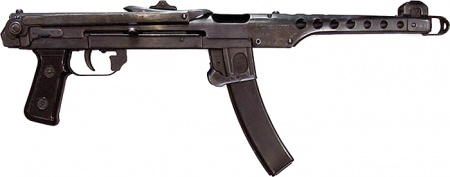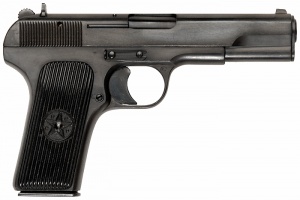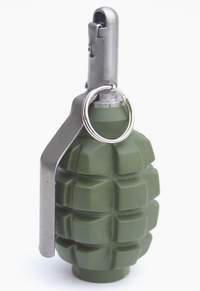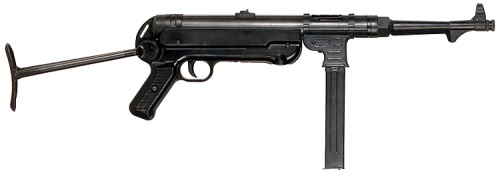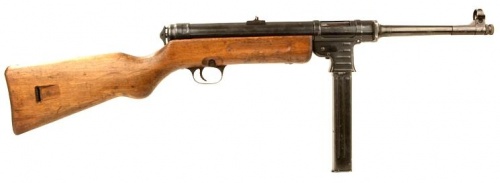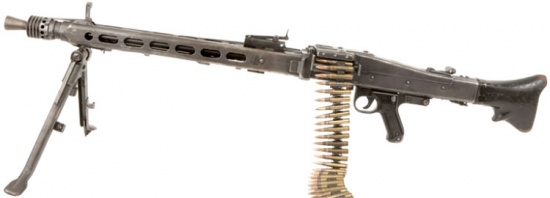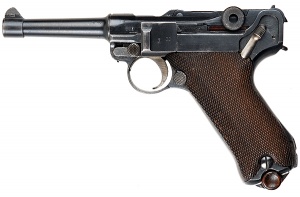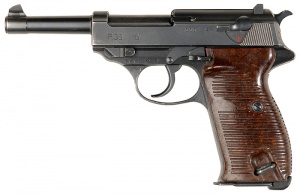| If you have been locked out of your account you can request a password reset here. |
Red Orchestra: Ostfront 41-45
Nice, but where's the trigger? This article or section is incomplete. You can help IMFDB by expanding it. |
Red Orchestra: Ostfront features a complete arsenal of WWII weapons for both the Soviet and German armies. The game is unique amongst first person shooters due to its high level of realism, including:
1) Iron Sights: Players can only aim via a weapon's actual iron sights, not via a graphical crosshair.
2) One Shot Death: Players can be killed by a single shot to any part of the body, not just the head as in other games. There are also no health packs or medics to heal wounds. Once a player dies, they respawn within 20 or 30 seconds and rejoin the battle. In order to keep the player from having to deal with the penalties of severe wounds in a moderately fast-paced shooter (while avoiding the 'health' system of other games), any wound that would make the player combat ineffective will 'kill' them, e.g. shots to the upper leg can cause the femoral artery to rupture and the player's corpse will fall to the ground and bleed out while the player themselves respawns.
3) Ballistics: Realistic ballistics are used for all weapons including rifles, pistols, machine guns, and tank weapons. However, tank shells had to be slowed to approximately half of their real-life velocity due to engine constraints.
4) Melee Attacks: Every firearm except for the machine guns and anti-tank rifle has a melee attack, consisting of a buttstock strike or - if a bayonet can be affixed to the weapon - a bayonet stab.
5) Magazine Management: Instead of numerical "ammo counters" as featured in other games, players need to mentally keep track of how many rounds they've fired from each magazine. The only indication of how much ammunition remains in the magazine is the weight; when replacing an old magazine with a fresh one, the game will indicate if the new magazine is "Heavy", "Light", or "Very light", giving the player an idea of how many rounds may remain inside.
6) Reinforcement System: Although on the surface this seems similar to the 'ticket' system used in games like the Battlefield series, the RO:O reinforcement system is independent of anything but how many players have been killed. This allows mappers to create the illusion of a larger force than a 25-player team being involved in the fight by reinforcing (respawning) enough players to fill a company or battalion, for example.
7) Artillery Support: In the same vein as the reinforcement system, ingame artillery can be adjusted for explosive power, time of flight, barrage strength and number of rounds in a barrage to simulate anything from mortars through to a field battery or rocket launcher (Nebelwerfer or Katyusha depending on side) battery.
A sequel to the game, Red Orchestra 2: Heroes of Stalingrad, was released on September 15, 2011.
Soviet Infantry Weapons
Mosin Nagant 91/30
The standard bolt action battle rifle of the Soviet Army featuring high accuracy and stopping power. It fires stripper clip-loaded 7.62x54R ammunition from a 5-round fixed magazine. The game allows the player to use the following variants: Full-length 91/30 with bayonet, shortened M1938 carbine without bayonet, shortened M1944 carbine with folding bayonet, and the PU-scoped 91/30 sniper without bayonet.
Tokarev SVT-40 Rifle
A semi-automatic battle rifle introduced just prior to the USSR's entry into WWII. The rifle fires the same 7.62x54R round as the Mosin Nagant, fed from 10-round box magazines. The game features both a standard, bayonet-capable version and a scoped sniper version. The SVT seen ingame is slightly anachronistic, as the plum-coloured finish on the bolt would mean the rifle had been through the postwar rearsenal process.
PPD-40
An early Soviet submachine gun firing 7.62x25mm Tokarev rounds from 71-round drum magazines. Due to its complexity, the weapon was phased out early in the war and replaced by the PPSh-41, so it only appears in the early war maps. While the real-life weapon is capable of firing from smaller box magazines, only the drum magazines are featured in the game. Due to an animation oversight, it appears to fire from a closed bolt ingame.
PPSh-41
The weapon that came to symbolize the Russian people's battle against the Germans in the Great Patriotic War, the "Pa-Pa-Sha" is a submachine gun firing 7.62x25mm ammunition from 71-round drum magazines. As with the PPD-40, in the game the PPSh-41 only uses drum magazines instead of a mix of box and drum magazines. Presumably due to an animation oversight, the PPSh-41 appears to fire from a closed bolt ingame.
PPS-43
The PPS-43 was designed to provide vehicle and scout crews with a compact but reliable submachine gun that would be easier to manage in tight quarters. Per these requirements, it features a folding stock and only uses 35-round box magazines instead of drums like the earlier PPD-40 or PPSh-41. Within the scope of the game, it is most commonly seen in the hands of officers, tank commanders, and specialized troops. Like both other Soviet submachineguns in the game, it appears to fire from a closed bolt rather than the real weapon, which fired from an open bolt. It is possible this is due to the developers using US-legal semiautomatic kits for animation references rather than truly authentic examples.
DP-28 Machine Gun
The Soviet standard light machine gun, it fires 7.62x54R rounds from a 47-round pan magazine affixed to the top of the weapon and uses a folding bipod. It features a reasonable rate of fire and accuracy, but unlike its German counterparts (and its real life counterpart) does not have interchangeable barrels; this was apparently done by Tripwire because their research suggested most DP gunners were not issued spare barrels. This can result in the weapon overheating and jamming if it is not allowed to cool.
DT Machine Gun
Based off of the DP-28 machine gun, this modified, more robust version is used on nearly all Soviet vehicles in Red Orchestra: Ostfront. It is mounted in the T-34/76 and /85 (co-axial and radio operator), IS-2 (co-axial only), T-60 (co-axial only), Universal Carrier (bow machine gunner), and BA-64 (turret-mounted).
PTRD-41
The PTRD is a single-shot anti-tank tank rifle firing the 14.5x114mm round. Unlike the later PTRS-41 weapon (not featured in the game) which has a 5-round fixed magazine, the PTRD can only hold one round at a time. After each round is fired, the bolt is held open and a new round is manually loaded into the breech, similar in fashion to a large field artillery gun. This makes the firing/reloading process slow and cumbersome. The rounds are useful against light infantry vehicles and early war tanks such as the Panzer III, but have considerable difficulty penetrating late war German tanks such as the Tiger or Panther. A single hit with the PTRD will easily kill infantry (more often than not removing limbs), leading to some RO:O players repurposing it as a sniper rifle with amusing results.
Tokarev TT-33
In the game, the TT33 is the standard sidearm issued to officers, machine gunners, snipers, and vehicle operators. It fires the standard 7.62x25mm Tokarev round from 8-round box magazines.
F-1 hand grenade
The standard fragmentation grenade in use by the Soviet forces. Each player can carry up to two of these weapons.
Note that the Soviets called it a "lemon" (limonka), not a "pineapple", and it also became the slang word for any frag grenade.
RDG-1 smoke grenade
A smoke grenade that covers a large area in white smoke. Two are typically carried by Soviet infantry commanders.
German Infantry Weapons
Karabiner 98k
The standard German battle rifle, it is a bolt-action weapon firing 7.92x57mm Mauser ammunition from a 5-round fixed magazine and features a detachable bayonet. It is accurate and powerful to great distances. Both the standard and scoped sniper variants are featured in the game, with the bayonet available only on the standard version.
Gewehr 41(W)
An early German semi-auto battle rifle, the weapon fires the standard 7.92x57mm Mauser round. Unlike its contemporary the SVT-40, its magazine was fixed and its gas system used a gas trap with an annular piston, rather than the more usual (and reliable) gas port with regular piston. As a result, the G41(W) was not very reliable, although this is not represented in the game since malfunctions aren't simulated. Reloading is performed via the top of the weapon via single rounds or 5-round stripper clips. In the game, you can only reload via 5-round stripper clips and only if you have fired more than 5 rounds.
Gewehr 43
Successor to the G41(W), firing the same 7.92x57mm Mauser round but using 10-round detachable box magazines. In the game, the player can equip either the standard version or the scoped sniper variant. The G43 was actually a reverse-engineered copy of the SVT-40, despite its similar appearance to the rifle it replaced, and its gas piston system greatly improved reliability. However, the rifle's gas system used so much power to cycle that the G43 had an unfortunate habit over time of 'beating itself to death'; this is not modelled ingame.
Sturmgewehr 44 (StG 44)
The prototype for all future assault rifles, the STG-44 is a weapon that combines the power of a battle rifle with the close-quarters effectiveness of a submachine gun. It fires the 7.92x33mm round from 30-round detachable box magazines and is featured in later war maps. The game allows the player to use a selector switch to alternate between semi-auto and full-automatic fire.
MP40/41
An effective submachine gun that features low rate of fire and low recoil, which makes for great accuracy and control. The MP-41 version is nearly identical aside from the replacement of the folding metal stock with a fixed wooden stock; this was only used in small numbers and mostly issued to police and other rear-area units, so it is unclear why Tripwire included it in the game. In the game it is commonly carried by squad leaders, tank commanders, and a small percentage of infantry.
MG34
The MG-34 is the standard early-war machine gun for the German players and the world's first true general-purpose machine gun (GPMG). It fires 7.92x57mm Mauser rounds from a side-mounted 50-round drum magazine and features replaceable barrels to prevent overheating. In the game, it can be fired from its bipod or from the hip, although the latter method is extremely difficult to control due to the heavy recoil and rate of fire. It is also featured in nearly every German vehicle in the game, including: Panzer III (co-axial and radio operator), Panzer IV F1/F2/G/H (co-axial and radio operator), Panther (co-axial and radio operator), Tiger (co-axial and radio operator), and SdKfz 251 halftrack (roof-mounted).
MG42
An updated version of the MG34 that was designed to supplant its earlier cousin. Originally intended to replace the MG34, the older design remained in use regardless until the end of the war, although the cheaper, stamped-metal MG42 overtook it by far in production. It has an extremely high rate of fire (1,200 rounds per minute) and, like the MG34, its barrel can be replaced to combat overheating. In the scope of the game, it can only be fired from its bipod, using 100-round belts of 7.92x57mm Mauser rounds.
Luger P08
The Luger P08 is a sidearm using a unique toggle mechanism instead of a standard pistol slide. Within Red Orchestra, the weapon is typically carried as a sidearm by tank crewmen, machine gunners, snipers, and infantry officers. Each magazine holds up to 8 rounds.
Walther P38
Like its predecessor, the Luger P08, the double-action Walther P38 is carried as a sidearm by tank crewmen, machine gunners, snipers, and infantry officers. Each magazine also holds 8 rounds.
Panzerfaust
A single-use anti-tank grenade used to great effect throughout the end of WWII. In the game, both sides have access to it on certain maps and measures are taken to simulate the aiming methods used by the real weapon, including the range scales and ballistics. It is highly effective in urban combat maps where tanks and vehicles are vulnerable to infantry attack from concealed positions.
Model 24 Stielhandgranate
The standard "stick" grenade in use by the German forces. Each player can carry up to two of these weapons.
Nebelhandgranate 39
A smoke grenade that covers a large area in white smoke. Two are typically carried by German infantry officers.









